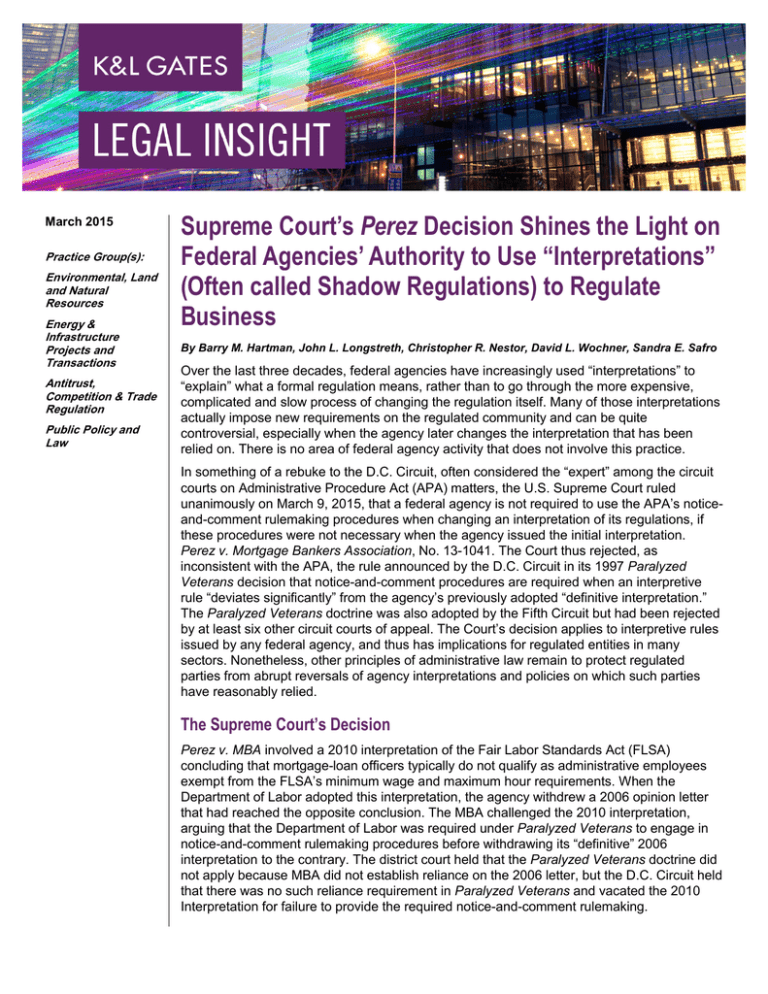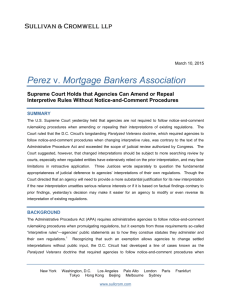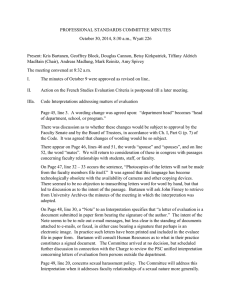
March 2015
Practice Group(s):
Environmental, Land
and Natural
Resources
Energy &
Infrastructure
Projects and
Transactions
Antitrust,
Competition & Trade
Regulation
Public Policy and
Law
Supreme Court’s Perez Decision Shines the Light on
Federal Agencies’ Authority to Use “Interpretations”
(Often called Shadow Regulations) to Regulate
Business
By Barry M. Hartman, John L. Longstreth, Christopher R. Nestor, David L. Wochner, Sandra E. Safro
Over the last three decades, federal agencies have increasingly used “interpretations” to
“explain” what a formal regulation means, rather than to go through the more expensive,
complicated and slow process of changing the regulation itself. Many of those interpretations
actually impose new requirements on the regulated community and can be quite
controversial, especially when the agency later changes the interpretation that has been
relied on. There is no area of federal agency activity that does not involve this practice.
In something of a rebuke to the D.C. Circuit, often considered the “expert” among the circuit
courts on Administrative Procedure Act (APA) matters, the U.S. Supreme Court ruled
unanimously on March 9, 2015, that a federal agency is not required to use the APA’s noticeand-comment rulemaking procedures when changing an interpretation of its regulations, if
these procedures were not necessary when the agency issued the initial interpretation.
Perez v. Mortgage Bankers Association, No. 13-1041. The Court thus rejected, as
inconsistent with the APA, the rule announced by the D.C. Circuit in its 1997 Paralyzed
Veterans decision that notice-and-comment procedures are required when an interpretive
rule “deviates significantly” from the agency’s previously adopted “definitive interpretation.”
The Paralyzed Veterans doctrine was also adopted by the Fifth Circuit but had been rejected
by at least six other circuit courts of appeal. The Court’s decision applies to interpretive rules
issued by any federal agency, and thus has implications for regulated entities in many
sectors. Nonetheless, other principles of administrative law remain to protect regulated
parties from abrupt reversals of agency interpretations and policies on which such parties
have reasonably relied.
The Supreme Court’s Decision
Perez v. MBA involved a 2010 interpretation of the Fair Labor Standards Act (FLSA)
concluding that mortgage-loan officers typically do not qualify as administrative employees
exempt from the FLSA’s minimum wage and maximum hour requirements. When the
Department of Labor adopted this interpretation, the agency withdrew a 2006 opinion letter
that had reached the opposite conclusion. The MBA challenged the 2010 interpretation,
arguing that the Department of Labor was required under Paralyzed Veterans to engage in
notice-and-comment rulemaking procedures before withdrawing its “definitive” 2006
interpretation to the contrary. The district court held that the Paralyzed Veterans doctrine did
not apply because MBA did not establish reliance on the 2006 letter, but the D.C. Circuit held
that there was no such reliance requirement in Paralyzed Veterans and vacated the 2010
Interpretation for failure to provide the required notice-and-comment rulemaking.
Supreme Court’s Perez Decision Shines the Light on Federal Agencies’
Authority to Use “Interpretations” (Often called Shadow Regulations) to
Regulate Business
The Supreme Court resolved the circuit split on this issue, holding that the APA by its terms
requires notice-and-comment procedures only for the issuance of “legislative rules,” that is,
rules that impose binding new legal requirements, and not for interpretive rules, which merely
“advise the public of the agency’s construction of the statutes and rules which it administers,”
and “‘do not have the force and effect of law.” Nor does the APA distinguish between initial
and subsequent agency action. Courts therefore cannot add a notice-and-comment
requirement for interpretive rules that the APA itself does not provide. The 2010
Interpretation was for that reason validly issued.
The Supreme Court’s decision on this point was not unexpected — an amicus brief filed by
dozens of leading administrative law experts stated that “when counsel for amici circulated a
draft of this brief, not a single scholar declined to join it on the ground that the position of the
D.C. Circuit below was correct.” Of more note, however, were the vigorous concurrences of
three Justices questioning whether agency interpretations reached without the use of noticeand-comment procedures should receive any deference from the courts, and suggesting
they would be open to the argument that courts should not defer at all to an agency’s
interpretation of its own rules.
Implications for Regulated Entities Challenging Interpretive Rules
There is probably no federal regulatory agency that will not be impacted by this decision and
any business or individual that deals with a federal agency may expect to experience the
ramifications of this decision either directly or indirectly. Legislative regulations, once in
place, cannot for the most part be challenged by a regulated entity in an enforcement action.
Agency interpretations of those regulations have historically been given so much deference
by courts that they too are in effect insulated from challenge. For many years, agencies have
increasingly used interpretations to avoid changing regulations and then relied on judicial
deference to insulate those interpretations from careful judicial scrutiny. This has left the
regulated community to suffer the consequences of agencies that change their positions
(especially when a new Administration takes office).
The most obvious implication of Perez v. MBA is that members of the Supreme Court seem
increasingly willing to reconsider the long-standing “Seminole Rock/Auer” doctrine of
deference to an agency’s interpretation of its regulations. Justice Scalia declared that
“enough is enough” on this issue two terms ago; Justice Thomas argued in his lengthy
concurrence that such deference “raises constitutional concerns” because it “effects a
transfer of the judicial power to an executive agency,” and the Chief Justice and Justice Alito
have also stated they are willing to reconsider the matter in an appropriate case.
Until such time as Auer may be reconsidered, parties must make do under existing
precedent, and Perez v. MBA removes an arrow from their quiver — at least in the D.C. and
5th Circuits. Yet regulated parties are not without recourse, as even the main opinion in
Perez v. MBA recognized the need to protect parties from unjustified or unreasoned
reversals of agency position. The decision leaves untouched the well-established rule that an
agency must acknowledge and provide an adequate explanation for its departure from
established precedent, so that it is clear that “prior policies and standards are being
deliberately changed, not casually ignored.” The Court also noted that many statutes,
including the FLSA, provide safe harbors for action taken in reliance on agency guidance.
2
Supreme Court’s Perez Decision Shines the Light on Federal Agencies’
Authority to Use “Interpretations” (Often called Shadow Regulations) to
Regulate Business
Finally, the Court cited the government’s acknowledgement that “actions against regulated
entities for conduct in conformance with prior agency interpretations may be limited by
principles of retroactivity.”
Other tools are available as well. First, it is well-established under the D.C. Circuit’s
Appalachian Power line of cases that an agency may not escape notice-and-comment
requirements “by labeling a major substantive legal addition to a rule a mere interpretation.”
While MBA did not argue that the rule at issue in its case was in fact a legislative rule
requiring notice and comment, and not an interpretive rule, that argument may be available
where a rule has practical binding effect, such as where parties will suffer adverse
consequences from failure to conform. Challengers can also seek to enforce rigorously the
requirement that a sufficient level of formality be provided for an agency interpretation to
receive deference, under the doctrine announced by the Supreme Court in United States v
Mead Corp. The D.C. Circuit has taken a somewhat relaxed view of Mead, but may be less
inclined to do so now that the protections of the Paralyzed Veterans doctrine are gone. Third,
the “fair warning” line of cases, including Gates & Fox v OSHA, serves to protect parties from
penalties or sanctions where an agency has not clearly and adequately expressed its intent.
Finally, when faced with a new interpretation it is sometimes possible to challenge that
process by petitioning the agency to promulgate that interpretation as a final rule and, if
unsuccessful, challenge the denial as being inconsistent with the APA because the
interpretation requires notice-and-comment rulemaking. All of these tools can protect
reliance, which Perez v. MBA acknowledged was a legitimate concern, even if the Court
does not proceed to consider the more drastic step suggested in the concurrences of
eliminating Auer altogether.
Sector-Specific Implications
Environmental
The Environmental Protection Agency relies on interpretations to clarify, and sometimes
alter, regulatory requirements. In Environmental Integrity Project v. EPA, 425 F.3d 992 (D.C.
Cir. 2005), for example, the D.C. Circuit held, relying on the Paralyzed Veterans doctrine,
that EPA orders in licensing proceedings were “definitive interpretation[s]” of legislative
regulations that could not be modified by a later interpretive rule absent notice-and-comment
rulemaking. Similarly, Creosote Council v. Johnson, 555 F.Supp.2d 36 (D.D.C. 2008), held
that where EPA had determined by letter and written instructions to regulated entities that
chemical releases were exempt from toxic release reporting, the agency could not
promulgate a new interpretation letter, stating that the same chemical releases were not
exempt, without first engaging in notice-and-comment rulemaking. Relying on Paralyzed
Veterans, the district court enjoined EPA from requiring compliance with the new
interpretation.
Energy
The Department of Interior and the Federal Energy Regulatory Commission utilize
interpretive rules in exercising their respective statutory authorities. For example, in Shell
Offshore Inc. v. Babbitt, 238 F.3d 622 (5th Cir. 2001), an offshore federal oil lessee relied on
a prior DOI interpretation of its regulations in calculating deductions from the lessee’s royalty
3
Supreme Court’s Perez Decision Shines the Light on Federal Agencies’
Authority to Use “Interpretations” (Often called Shadow Regulations) to
Regulate Business
payments under its FERC-approved tariff. When the agency changed its position to require
an affirmative FERC determination that FERC had jurisdiction over the relevant pipeline, the
Fifth Circuit held that the agency was bound by its prior practice of not requiring a formal
FERC determination. Citing Paralyzed Veterans, the court held DOI’s new practice was a
“significant departure from long established and consistent practice, and should have been
submitted for notice and comment before adoption.” Also relying on Paralyzed Veterans, the
D.C. Circuit reached the same conclusion on nearly identical facts in Torch Operating Co. v.
Babbitt, 172 F. Supp. 2d 113 (D.C. Cir. 2001).
Labor
For more than 30 years, the Department of Labor has announced its FLSA interpretations by
issuing written “Opinion Letters” in response to inquiries from private parties seeking
guidance. As reflected by the Perez case itself, DOL now has more flexibility in changing
these interpretations. The Perez case would also likely have led to a different result in United
Farmworkers of America v. Chao, 227 F. Supp. 2d 102 (D.D.C. 2002). That case invalidated
a DOL change in policy delaying its publication of certain wage rates on which the plaintiffs’
compensation was based, and held that DOL had to adhere to its original policy as to
publication of these rates unless and until it provided opportunity for notice and comment.
Securities
The securities area is one in which a change to the Auer/Seminole Rock deference doctrine,
which several members of the Supreme Court would like to revisit, could be especially
significant. One example is SEC v. Simpson Capital Mgmt., Inc., 586 F.Supp.2d 196
(S.D.N.Y. 2008), in which the district court deferred to the SEC’s interpretation of its “forward
pricing rule” and upheld the agency’s enforcement action against a company and several
brokers. Without such deference, the agency will have to be very precise in drafting its rules,
a stated goal of the justices who would like to revisit Auer.
Conclusion
Perez v. MBA will eliminate a constraint all agencies have faced in changing interpretations
of their rules and has the potential to impact a wide range of activity. At the same time, it may
portend greater substantive scrutiny of agency interpretations. Regulated parties still have
other doctrines available to protect themselves from unjustified and unexplained changes in
agency interpretations or guidance.
Authors:
Barry M. Hartman
barry.hartman@klgates.com
+1.202.778.9338
John L. Longstreth
john.longstreth@klgates.com
+1.202.661.6271
4
Supreme Court’s Perez Decision Shines the Light on Federal Agencies’
Authority to Use “Interpretations” (Often called Shadow Regulations) to
Regulate Business
Christopher R. Nestor
christopher.nestor@klgates.com
+1.717.231.4812
David L. Wochner
david.wochner@klgates.com
+1.202.778.9014
Sandra E. Safro
sandra.safro@klgates.com
+1.202.778.9178
Anchorage Austin Beijing Berlin Boston Brisbane Brussels Charleston Charlotte Chicago Dallas Doha Dubai Fort Worth Frankfurt
Harrisburg Hong Kong Houston London Los Angeles Melbourne Miami Milan Moscow Newark New York Orange County Palo Alto Paris
Perth Pittsburgh Portland Raleigh Research Triangle Park San Francisco São Paulo Seattle Seoul Shanghai Singapore Spokane
Sydney Taipei Tokyo Warsaw Washington, D.C. Wilmington
K&L Gates comprises more than 2,000 lawyers globally who practice in fully integrated offices located on five
continents. The firm represents leading multinational corporations, growth and middle-market companies, capital
markets participants and entrepreneurs in every major industry group as well as public sector entities, educational
institutions, philanthropic organizations and individuals. For more information about K&L Gates or its locations,
practices and registrations, visit www.klgates.com.
This publication is for informational purposes and does not contain or convey legal advice. The information herein should not be used or relied upon in
regard to any particular facts or circumstances without first consulting a lawyer.
© 2015 K&L Gates LLP. All Rights Reserved.
5



